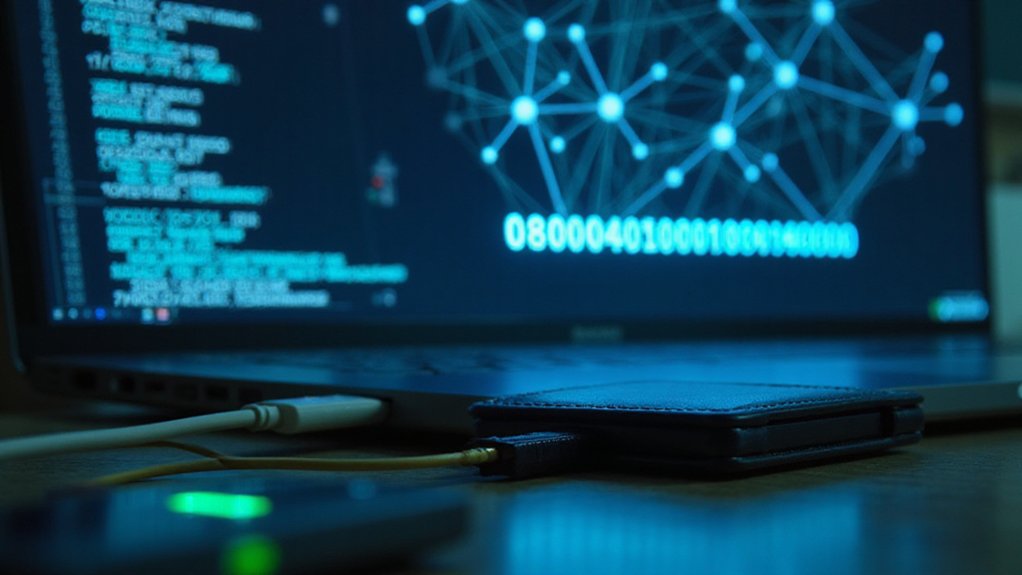A TXID (transaction ID) serves as a blockchain transaction’s unique 64-character digital fingerprint, basically the receipt number in cryptocurrency’s distributed ledger system. Generated through double SHA-256 hashing, this alphanumeric identifier incorporates sender and recipient addresses, transfer amount, fees, and timestamp—creating an immutable record that enables public verification, transaction tracking, and troubleshooting. This cryptographic cornerstone, virtually impossible to fabricate, represents how blockchain elegantly replaces institutional authority with mathematical certainty and transparent accountability. The deeper mechanics reveal an even more fascinating security architecture.

A TXID, or Transaction ID, stands as the cryptographic cornerstone of blockchain’s much-vaunted transparency—a unique alphanumeric string that serves as the digital fingerprint for every transaction ever executed across distributed ledgers. These 64-character strings (prefixed with “0x” in Ethereum’s case, though Bitcoin abstains from such formalities) function basically as the receipt numbers of the digital asset ecosystem, allowing participants to trace the movement of value with unprecedented precision.
The generation of these identifiers involves considerably more cryptographic sophistication than one might initially suspect.
Through the application of SHA-256 hashing algorithms—performed not once but twice, as if single encryption weren’t sufficiently secure—the system transforms a transaction’s constituent elements into an inimitable code. The sender’s address, recipient’s details, transfer amount, associated fees, and timestamp all contribute to this digital distillation, producing a string so unique that even microscopic alterations to input data would yield an entirely different result. The distinctive nature of TXIDs provides crucial fraud prevention for cryptocurrency transactions across the blockchain network. Blockchain explorers serve as essential tools for investigators tracking these identifiers across transaction patterns to establish connections between different wallet addresses.
This cryptographic alchemy serves multiple practical functions beyond mere identification.
Users rely on TXIDs to track pending transfers through blockchain explorers, verify completed transactions, and troubleshoot anomalies when funds appear to vanish into the digital ether (which happens with alarming frequency for blockchain novices). For enterprises and regulatory bodies, these identifiers facilitate audit trails that would make traditional accountants weep with joy—immutable, chronological, and resistant to even the most determined falsification attempts. Due to new UK rules, certain educational pages about TXIDs and other blockchain concepts may be temporarily unavailable on some platforms.
The TXID’s conceptual elegance lies in its fusion of accessibility and security.
The elegant blockchain paradox: utterly public verification meets impenetrable cryptographic certainty.
Anyone with internet access can verify transaction authenticity without intermediaries, yet the underlying cryptographic principles render fabrication effectively impossible.
This elegant balance between transparency and security exemplifies blockchain’s revolutionary approach to trust architecture—replacing institutional authority with mathematical certainty, and transforming “trust me” into “verify yourself,” a paradigm shift whose implications continue to ripple through financial systems worldwide.¹
¹And occasionally cause those systems considerable consternation.
Frequently Asked Questions
How Long Does It Take for a TXID to Be Confirmed?
TXID confirmation time varies dramatically across blockchain networks, with Bitcoin averaging 10 minutes per confirmation (typically requiring 3-6 for security), while Ethereum completes the process in seconds to minutes.
Network congestion and transaction fees play decisive roles—higher fees effectively purchasing priority in miners’ queues.
The blockchain’s fundamental architecture dictates these timeframes; proof-of-stake networks generally confirm faster than their proof-of-work counterparts.
During peak congestion, underpaid transactions may languish for hours or days.
Can a TXID Be Changed or Modified After Submission?
No, a TXID cannot be changed or modified after submission to the blockchain.
Once generated through the double-SHA-256 hashing process, TXIDs become immutable components of the permanent ledger.
This immutability—a cornerstone of blockchain’s security architecture—ensures that transaction records remain tamper-proof by design.
Any attempt to alter transaction data would simply generate an entirely different TXID rather than modifying the existing one, thereby maintaining the integrity of the blockchain’s historical record.
What Causes a Transaction to Get Stuck With Pending TXID?
Transactions can languish in blockchain purgatory due to several technical failings: network congestion (the digital equivalent of rush-hour traffic), miserly fee allocations that miners predictably ignore, blockchain infrastructure hiccups, wallet configuration errors, or insufficient confirmations from network nodes.
The modern financial dilemma—your digital assets, suspended in the ether, neither here nor there.
Most stuck transactions eventually process or expire, though one wonders if there’s a special circle of Dante’s Inferno for perpetually pending TXIDs.
How Do I Recover Funds Sent to the Wrong TXID?
Recovering funds sent to the wrong TXID is, unfortunately, a nearly Sisyphean task given blockchain’s immutability (that much-touted feature becomes rather inconvenient in such situations).
Options are scarce: contact the exchange if the transaction occurred there, reach out to the recipient if identifiable, or report to blockchain support services.
Prevention remains the only reliable strategy—double-checking addresses, using verification tools, and conducting test transactions before significant transfers would have circumvented this predicament entirely.
Are TXIDS the Same Across Different Cryptocurrency Networks?
No, TXIDs are not identical across different cryptocurrency networks.
While they serve the same fundamental purpose—uniquely identifying transactions—each blockchain implements its own formatting conventions.
Ethereum transactions, for instance, typically feature a “0x” prefix, whereas Bitcoin TXIDs do not.
The underlying hash functions (commonly SHA-256) remain consistent across many networks, but the resulting identifiers are network-specific, rendering cross-chain TXID compatibility something of a cryptographic impossibility.









